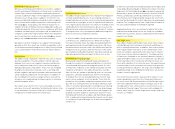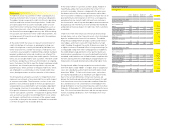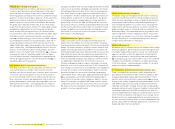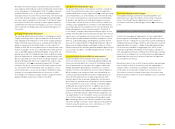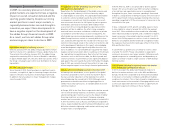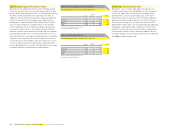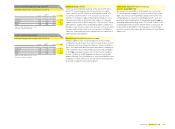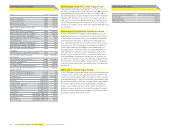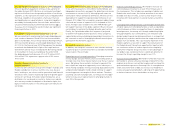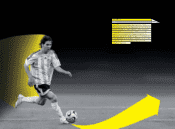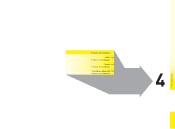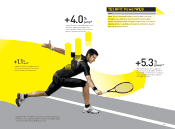Reebok 2008 Annual Report Download - page 123
Download and view the complete annual report
Please find page 123 of the 2008 Reebok annual report below. You can navigate through the pages in the report by either clicking on the pages listed below, or by using the keyword search tool below to find specific information within the annual report.
adidas Group Annual Report 2008 119
We expect the market for personalised and customised foot-
wear, apparel and hardware to grow strongly and evolve further
in the coming years. In September 2008, the adidas segment
acquired Textronics, Inc., a specialist in the development of
wearable sensors for use in fi tness monitoring. The technology
will fi rst be utilised in adidas running apparel and expanded
into other sports categories in the future. It will be an impor-
tant facet of the miCoach offering as smart apparel products
complement the miCoach technology accessories. miCoach
aims to provide 360 degree personalised training regimes to
consumers.
Breaking new ground in distribution
The sporting goods retail environment is changing constantly.
People increasingly want to get involved with our brands. We
have adapted our distribution to cater to this change and have
made controlled space initiatives a strategic priority. We intro-
duced e-commerce in the Netherlands as a test market for
Europe in 2008. We also see opportunities to operate new shop
formats. Examples of this are co-branded stores with partners
such as the NBA (adidas) and NHL (Reebok). In July 2008, we
opened the world’s fi rst adidas Brand Center in Beijing, taking
the retail experience to a new level see adidas Strategy, p. 048.
We also launched new store formats for adidas Originals called
Atelier and Studio. Rockport is also planning to launch a new
store format in 2009 see Reebok Strategy, p. 052. Through
initiatives like these, we can more effectively target consum-
ers and involve them emotionally with our products. In our
wholesale business, we are increasing our fl exibility to utilise
changes in consumption behaviour as they arise. In 2008,
for example, we rolled out a unique shop-in-shop partnership
between Reebok and a major retailer in the USA.
Taking control of distribution rights
Our brands do business in virtually all countries around the
world. The majority of our business is done through fully-
owned subsidiaries or sales organisations see Group Strategy,
p. 046. Nevertheless, in some markets, we work with distribu-
tors or joint venture partners, in particular at brand Reebok.
In doing so, we capitalise on third-party expertise in terms
of how to best service retailers in those countries. While this
strategy can be appropriate in a market’s early development,
we strongly believe in having full control over distribution and
brand management in more mature markets. Therefore, it
is our Group’s strategy to buy back distribution rights for our
brands when possible and economically sensible. Over the last
several years, we have been very successful in this respect. In
2008, we purchased /founded two Reebok companies in Latin
America, in Brazil /Paraguay and Argentina. In 2009, we will
take over the remaining 25% of Reebok distribution rights in
Spain and consolidate adidas and Reebok’s Spanish offi ces.
Going forward, we will evaluate potential buyback opportunities
on a case-by-case basis, considering opportunities as well as
inherent risks.
Cost optimisation drives profi tability improvements
Continued optimisation of key business processes and
strict cost control are vital to achieving high profi tability and
return on invested capital. As a result of the Reebok acquisi-
tion, we generated cost synergies that support adidas and
Reebok profi tability development. Nonetheless, our profi t
margins continue to be below those of our main competitors.
We do, however, see numerous levers for streamlining our
cost base going forward. We can further simplify processes
across brands and functions to reduce operational ineffi -
ciencies owed to the increased complexity of our Group. In
North America, we believe we will be able to realise medium-
term economies of scale as we continue to integrate adidas
and Reebok back-offi ce functions. In addition, we strive to
further increase effi ciency in our supply chain and make it
truly demand-driven. By implementing end-to-end planning
processes and improving our replenishment capabilities, we
see opportunities to not only better serve our customers but
also to further reduce our operating working capital needs
see Global Operations, p. 064. Another example is the reduc-
tion of the number of articles, which reduces workload in the
creation area and warehouse costs, and allows us to offer
more focused ranges to our retail partners.
Financial Opportunities
Favourable fi nancial market changes
Favourable exchange and interest rate developments can
potentially have a positive impact on the Group’s fi nancial
results. Our Group Treasury department closely monitors
the fi nancial markets to identify opportunities see Treasury,
p. 093.
Management Assessment of Overall Risk and Opportunities
Central risk management aggregates all risks reported by
brand, regional and headquarter functions. Based on the com-
pilation of risks – taking into account the occurrence likelihood
and potential fi nancial impact and the current business outlook
explained within this report – adidas Group Management does
not foresee any individual or aggregate risks which could
materially jeopardise the viability of the Group as a going con-
cern. Management remains confi dent that the Group’s earnings
power forms a solid basis for our future business development
and provides the necessary resource to pursue the opportuni-
ties available to the Group.
Nonetheless, due to the current fi nancial market and exchange
rate volatility as well as uncertainty over the magnitude of
spillover effects on private consumption, we believe that our
risk profi le has increased in comparison to the prior year.
This refl ects increases in both likelihood of occurrence and
potential fi nancial impact of certain individual risks as outlined
in this report.




